New methods of planting potatoes and care features
Potatoes are an unpretentious crop that grows on all types of soil. In order to obtain the maximum vegetable yield from a small area under different agroclimatic conditions, various options for its cultivation have been created. In this article we will tell you how potatoes are sown.
How to grow a large potato harvest
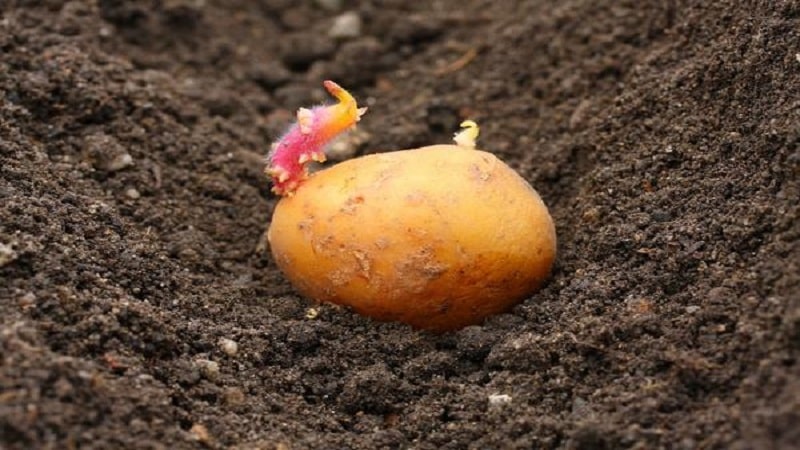
Potato yield depends on:
- quality of planting material;
- soil fertility;
- location beds;
- planting method;
- care;
- disease prevention and pest control.
Preparing potatoes for planting
Preparing potatoes for planting includes treatment with disinfectants and growth stimulants, as well as germination of tubers. Seed material is disinfected to prevent diseases and pest damage. Treatment is carried out by soaking the tubers in purchased disinfectant solutions according to the instructions. To speed up the emergence of seedlings, they resort to growth stimulants, watering the sprouted tubers with them 2 days before planting in open ground.
Attention! If the potatoes were purchased from an unknown manufacturer or received during the rainy season, disinfection with fungicides is recommended.
For germination, the tubers are placed in the light, sprayed with water daily and turned over once every 3 days. With the wet method, the potatoes are placed in boxes, sprinkled with peat or perlite, and taken out to a cool place.By regularly moistening the substrate, sprouts and roots appear.
The combined method includes the previous two. First, the planting material is kept in the light for several weeks at a temperature of +10°C, subjected to daily turning and spraying. After the first shoots appear, the potatoes are transferred to a humid environment for 3 weeks to form roots.
Traditional planting methods
Traditional planting methods include smooth, ridge and trench methods.
Basic planting patterns
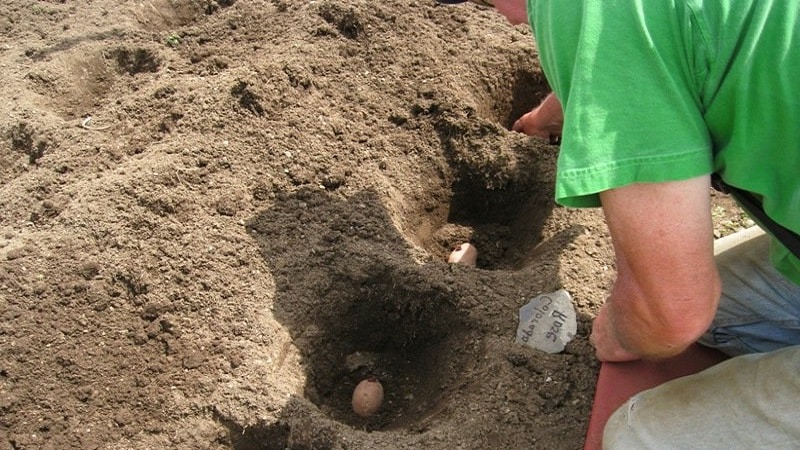
The distance between tubers depends on the potato variety. Scheme for early varieties: distance between rows – 60 cm, between tubers – 30 cm. When planting late varieties, the figures increase by 10 cm. Planting depth ranges from 4-5 cm on clay soils, to 10-12 cm on sandy soils.
Landing under a shovel
On loose and moisture-absorbing soil, potatoes are planted under shovel. Small holes are made in the designated rows into which the tubers are placed. Each planting is covered with soil from a hole in a parallel row.
Planting in ridges
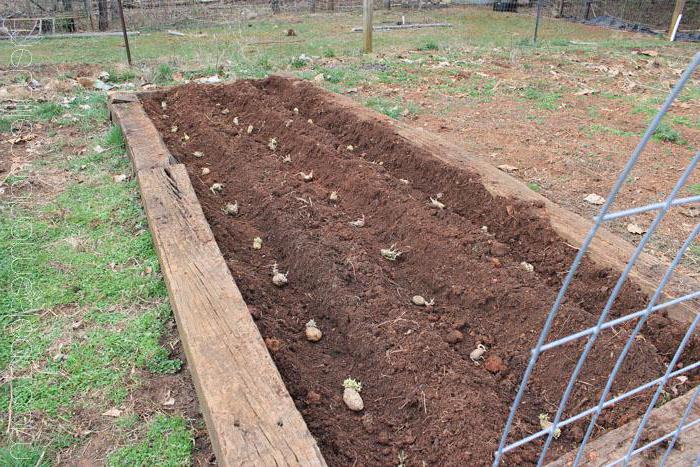
Ridges are narrow strips of dug up earth. They come in both single and double. In the latter case, the planting holes are arranged in a checkerboard pattern. The interval between the ridges is 25-30 cm. This arrangement helps to increase the number of tubers and their weight, and also helps to avoid infection of potatoes with late blight.
In the trench
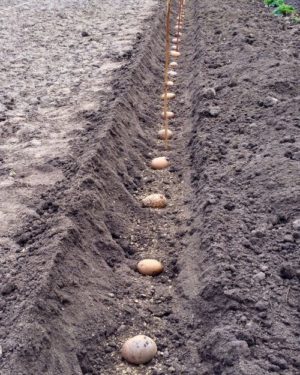
The trench planting method has proven itself well in conditions of insufficient humidity. Sprouted tubers are placed in deep (up to 0.5 m) trenches filled with plant debris and soil mixed with wood ash. Planting material is sprinkled with peat humus mixture and covered with film.After the shoots emerge, the film is removed, and the sprouts are sprinkled with compost and covered again. After the second germination, the procedure is repeated, after which holes are cut in the film for young plants.
Reference. The film suppresses the growth of weeds and also eliminates the need for hilling and loosening the soil.
Into the ridges
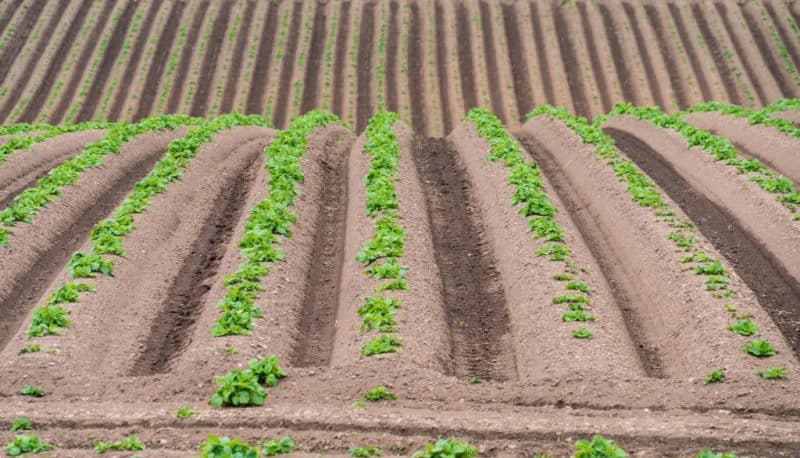
Used in areas with close groundwater and on heavy soils. Potatoes are planted in ridges 15 cm high, located at a distance of 70 cm from each other. The embedment depth is from 6 to 8 cm. The holes are dug at a distance of 25-30 cm from the edge of the embankment.
Deep landing
The American method involves planting tubers according to a 22x22 cm pattern at the same depth. Suitable for late plantings, when the soil warms up to a greater depth, as well as for light soils that quickly lose moisture.
New planting methods
If there is not enough space to obtain a large harvest, they resort to new methods of sowing potatoes - in containers.
In bags
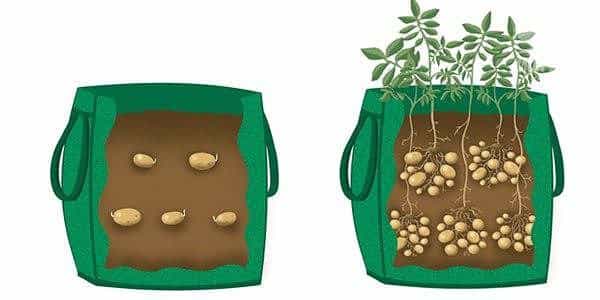
Growing in bags goes like this:
- The bottom of the container is filled with a layer of humus (up to 30 cm).
- Place the sprouted tubers at a distance of 25 cm from each other.
- Sprinkle the potatoes with a mixture of earth and humus (8-10 cm layer).
- Water immediately after planting and as needed.
- Add the nutrient mixture as the shoots grow every 5-6 cm in an amount twice the height of the plant.
- Harvest after the tops dry out.
In barrels
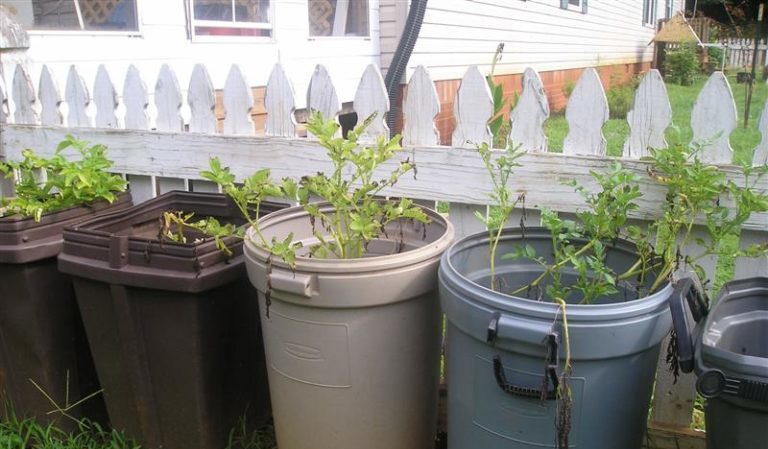
The scheme for growing in barrels is similar to harvesting from bags. The difference lies in the characteristics of the container: the bottoms of wooden barrels are removed before planting, while in plastic containers drainage holes are made on the walls and bottom.
In boxes
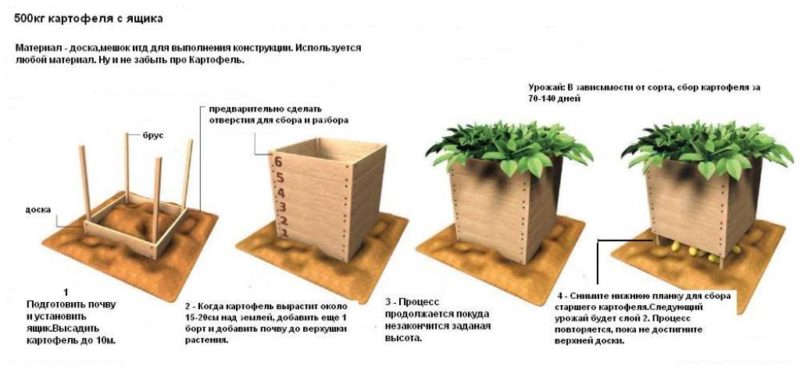
In addition to barrels and bags, it is practiced to use other available containers: wooden and plastic boxes, various containers. The growing technology remains the same as in the case of barrels and bags.
Important! The main requirement when growing potatoes in containers is good drainage.
Unconventional methods
New methods of planting and caring for potatoes differ from traditional ones in that they do not involve digging up the soil and hilling up the beds.
Planting without digging
Digging and loosening the soil destroys its top fertile layer, as a result of which plant roots feel a lack of necessary substances. The technology for growing potatoes without digging involves obtaining tubers on horizontal shoots-stolons, which grow from the base of the stem.
Planting in the grass
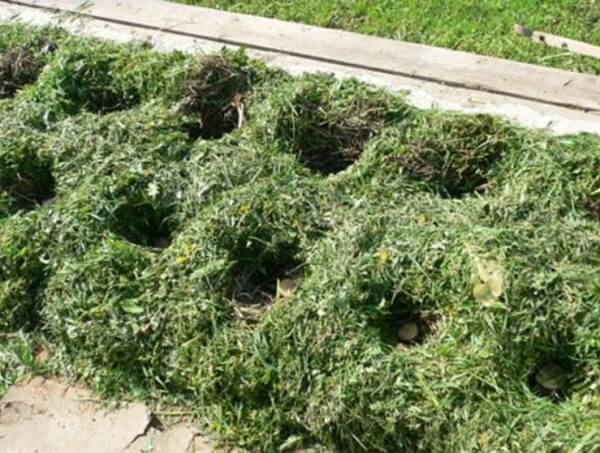
The area overgrown with grass is not dug up, and the beds are marked immediately on the virgin soil at a distance of 50 cm from each other. Sprouted potatoes are placed 2-3 in each planting nest at intervals of 25 cm and covered with darkening, airtight material (hay, dry leaves, dried compost). To protect from the wind, the bed is covered with lutrasil or burlap. Later it is replaced with organic waste, regularly updating the compost layer.
In high beds
Planting in high beds (ridges) facilitates the work of cultivating a potato field. In the prepared area, ditches are made to delimit the beds. The sprouted tubers are laid out in a row 25 cm apart and covered with soil using a hoe, forming a high bed.
Into the sawdust
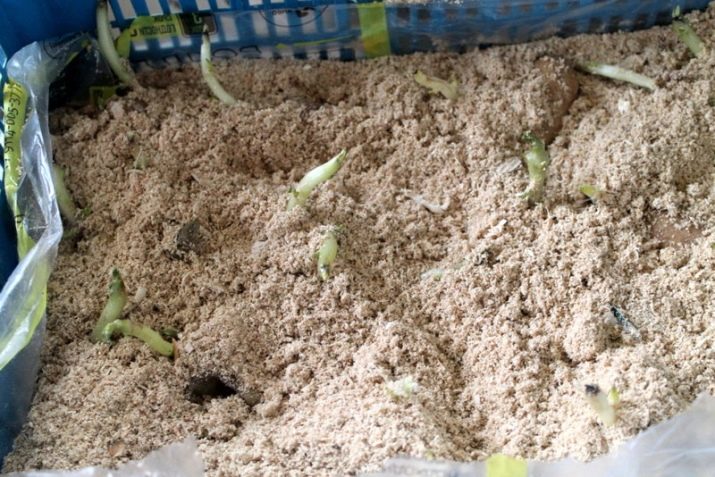
The method is well suited for growing early potato varieties.The sprouted planting material is laid out on the surface of the ground, sprinkled with a layer of old sawdust mixed with rotted manure so that the tubers are completely covered. As the sawdust decomposes, their layer is renewed.
Reference. Only old sawdust is used so as not to cause the potatoes to rot.
Square nest method
When planting in square nests, the area is marked out so that the potato bushes are located at the corners of imaginary squares. This reduces plant competition for sunlight, water and nutrients. An important condition for obtaining a good harvest is careful hilling and watering of the crop.
Under the mulch
Caring for potatoes is made easier by covering them with mulch. The protective layer eliminates the need for weeding and hilling, and also significantly reduces the amount of watering. Hay or straw, which condenses moisture, is used as mulching material.
Under the straw
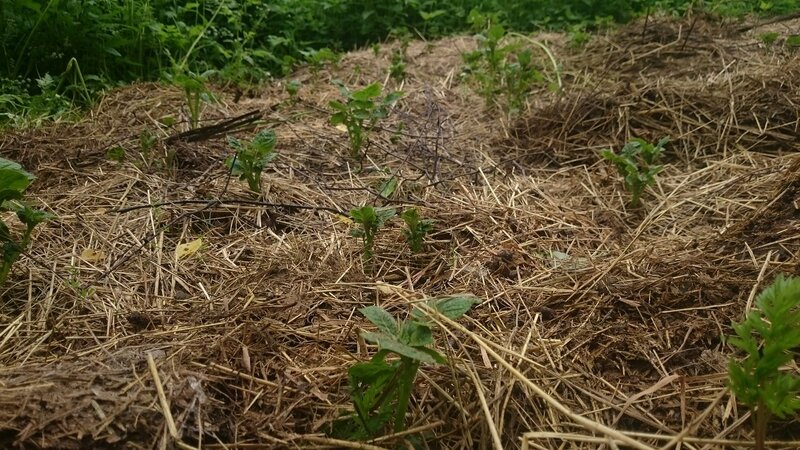
Planting under straw used on virgin lands and heavy soils. When laying out the potatoes on a flat surface or in shallow holes, do not sprinkle them with earth, but cover them with a thick layer of straw, adding it as the shoots grow.
Cascade
When cultivating land in hilly areas, they use the cascade method, forming furrows and ridges across the slope. Potatoes are planted in depressions, covered with soil from the ridges. The resulting ditches retain water, which ensures the quality of the crop.
Under the stake
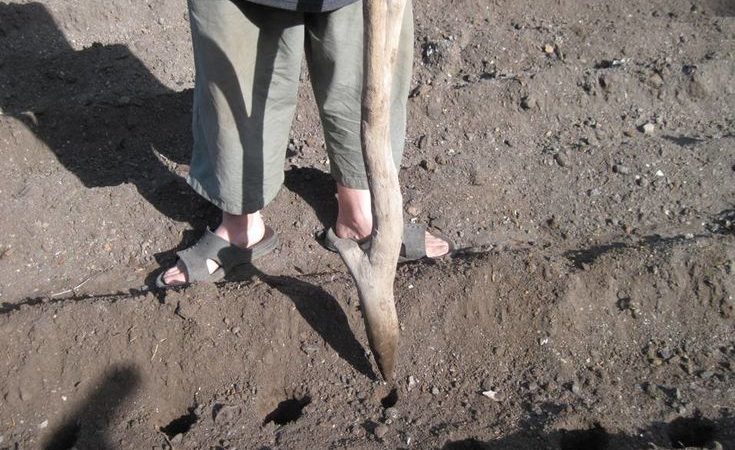
The stake is a bar with teeth for evenly making holes. Potato tubers are laid out in the resulting holes and sprinkled, slightly pressing them into the ground. The method allows you to reduce the cost of time and effort.
To the mounds
The tubers are laid out in holes made along the diameter of the marked circles every 25-40 cm, and sprinkled with earth. As they grow, the bushes hill up, forming a hill, in the middle of which there is a deep hole for watering.
Chinese way
Sprouted tubers are lowered into deep (at least 70 cm) and wide holes, covered with a mixture of soil with manure and superphosphate in a layer of no more than 10 cm. The rest of the hole is left empty. When the bush grows, it is sprinkled again, leaving no more than 5 cm of the plant above the surface. Repeating the procedure several times, a small hill is obtained around the bush.
Important! Potatoes do not need hilling or weeding.
Under cardboard
The surface of the area is moistened and covered with overlapping sheets of thick cardboard, in which X-shaped cuts are made at a distance of 25-30 cm from each other. Sprouted tubers are placed there and the edges of the sheets are closed. As they sprout, the shoots are mulched with straw, replenishing it if necessary.
Planting with a walk-behind tractor
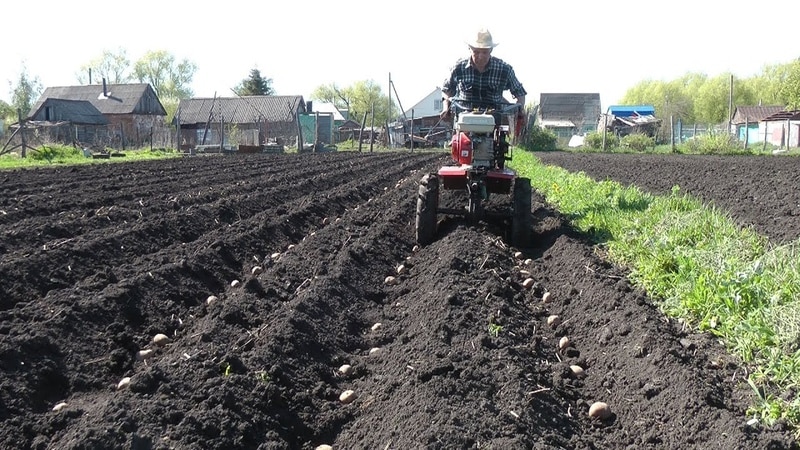
In small areas, potatoes are planted using a walk-behind tractor with a hiller. The lug wheels of the mechanism make even furrows into which the potatoes pouring out of the hopper are placed. Then, using a hiller, the tubers are covered with soil, compacting it at the same time.
Planting in a greenhouse
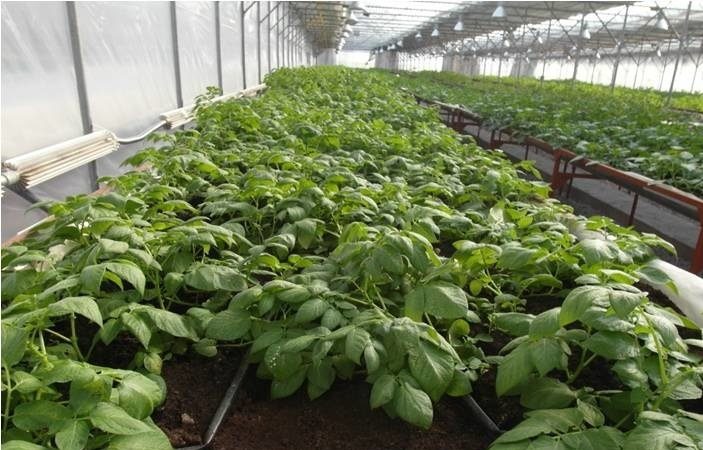
In heated greenhouses, potatoes are planted at the end of August and the last days of February. Only green sprouted tubers that have been treated against pests are used. Put in fertilized soil, the surface temperature of which is not less than +5°C to a depth of 6-7 cm. In this case, the width of row spacing ranges from 60 to 65 cm, and the distance between holes in a row is from 25 to 30 cm.
Attention! When planting potatoes in a greenhouse, the tubers cannot be cut, as the smell of fresh juice will attract pests.
In unheated greenhouses, potatoes are planted only in the spring under spunbond.
Planting under film and agrofibre
You can grow early potatoes without the risk of being damaged by frost using film or agrofibre.
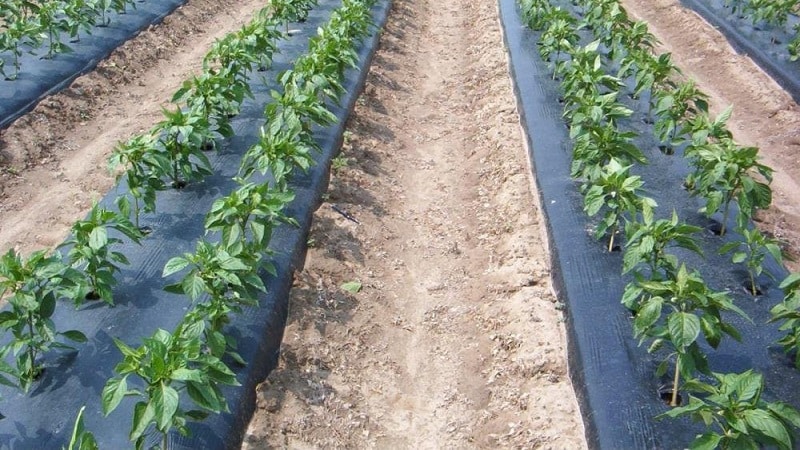
Features of growing under film
After planting, the potatoes are covered with film, pressing it along the edges so as not to be blown away by the wind. After germination, the polyethylene is regularly removed for ventilation. When the ambient temperature rises, keep the seedlings slightly open to avoid overheating. At night they are completely covered.
Growing under agrofibre
Unlike film, agrofibre allows moisture and air to pass through, which makes caring for the beds easier. If there is a threat of severe frost, the non-woven material is additionally insulated with film.
Original methods
Unusual, but scientifically proven methods of growing potatoes help to get a rich harvest with a minimum of labor costs.
Fokin method
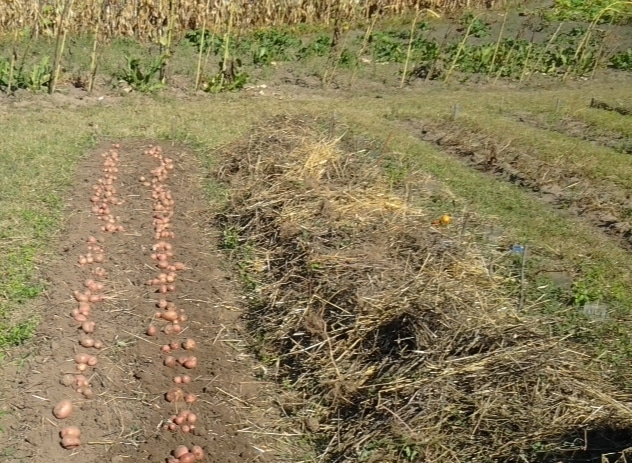
Fokin is the creator of a flat cutter, a device that facilitates the farming process. When growing potatoes, it allows you to form furrows and beds, as well as hill up.
Joint planting with legumes
Legume seeds are sown after potatoes in the same row, placing them between potato bushes. This proximity helps to compact the plantings, enrich the soil with nitrogen compounds and protect against the Colorado potato beetle.
According to Mittleider
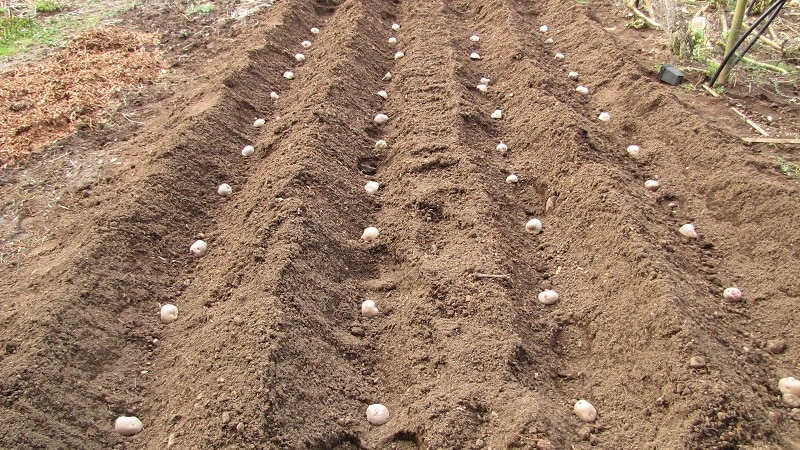
Method involves the use of narrow ridges with wide passages between them. Potatoes are provided with access to nutrients while using water sparingly.
Gülich technology
The tubers are laid out in nests filled with manure, formed in the center of squares with a side of 49 cm. Then the planting material is again covered with manure and covered with a mound of earth in the form of a pyramid. Care involves removing weeds and adding pyramids.
Dutch technology
Potatoes are planted into long furrows into small depth, which ensures free penetration of air to the roots, good lighting and prevents the accumulation of excess moisture.
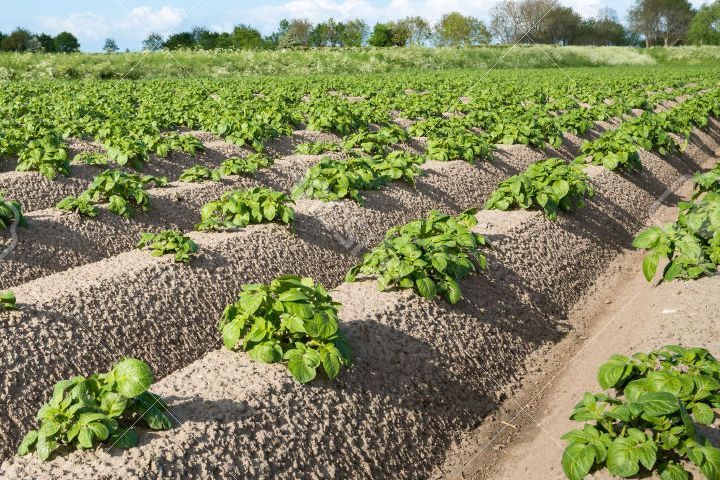
Balabanov method
Tubers are planted in ridges delimited by wide row spacing (up to 120 cm). The soil is not dug up, but planting material is lowered into small holes at the top of the ridge.
Folk method
Circular cutting of tubers to a depth of 1 cm before planting promotes massive growth of lower buds and uniform distribution of nutrients.
Other
Flowering potato buds are torn off and the stems are broken off to increase yield. However, this method is associated with damage to the plant and can have unpleasant consequences.
Tips and tricks
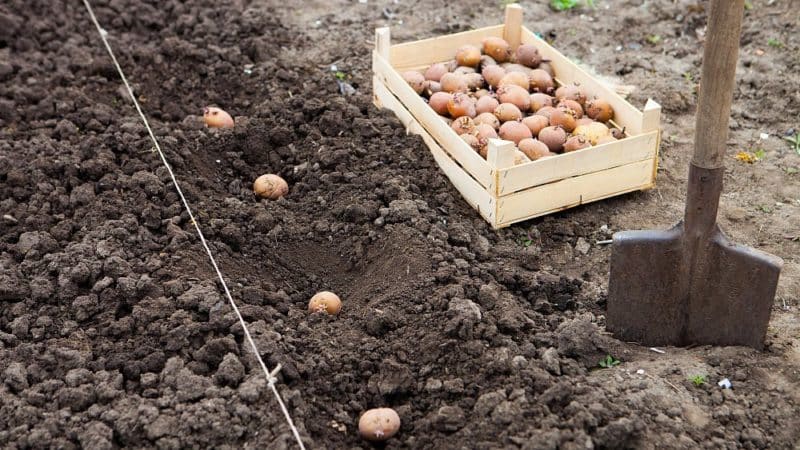
Advice from experienced vegetable growers:
- Good lighting of the area.
- The wetter the soil, the shallower the depth the tubers are planted.
- The distance between planting holes is at least 25 cm.
- The row spacing ranges from 50 cm.
- Potatoes are planted in warm soil.
- It is better not to hill up the bushes, but to cover them with earth.
Conclusion
Growing potatoes using the traditional method takes a lot of effort and time. The use of non-standard methods, for example, without hilling, digging up the ground, using containers, etc., helps to simplify this process and get a rich harvest from a small area.